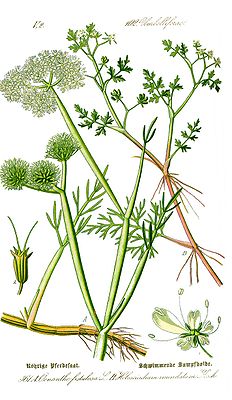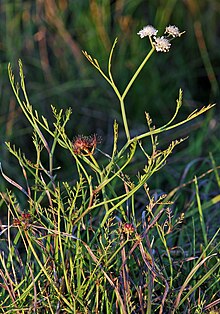Tubular water fennel
| Tubular water fennel | ||||||||||||
|---|---|---|---|---|---|---|---|---|---|---|---|---|

Tubular water fennel ( Oenanthe fistulosa ), illustration |
||||||||||||
| Systematics | ||||||||||||
|
||||||||||||
| Scientific name | ||||||||||||
| Oenanthe fistulosa | ||||||||||||
| L. |
The tubular water fennel ( Oenanthe fistulosa ), also known as tubular horse seed , is a species of water fennel ( Oenanthe ) within the umbelliferae family (Apiaceae). It is a water and swamp plant.
description
Vegetative characteristics
The tubular water fennel grows as a perennial herbaceous plant and reaches heights of 30 to 60, rarely up to 80 centimeters. It has spindle-shaped to egg-shaped tubers. The stems are striped, hollow and thin-walled and often constricted at the nodes.
The basal and alternate leaves arranged on the stem are divided into a petiole and a leaf blade. The basal leaves are single to double pinnate, their leaf lobes are ovate and lobed. The stem leaves are simply pinnate with linear-lanceolate narrow undivided tips.
Generative characteristics
The flowering period is between June and August. The terminal double-gold inflorescences have two to four rays, which are thickened at the time of fruiting. Only the outer flowers of the little bulbs are stalked, the others are seated, so that they form a ball at the time of fruiting.
The fruit is 3 to 4 millimeters long, cylindrical or conical. The styles are as long as the fruit.
Chromosome number
The number of chromosomes is 2n = 22.
Occurrence
The tubular water fennel occurs in Morocco, Algeria, Tunisia, Spain, Portugal, France, Corsica, Sardinia, Sicily, Great Britain, Denmark, Sweden, Italy, Germany, Belgium, Luxembourg, the Netherlands, Switzerland, the Czech Republic, Austria, Hungary, Poland, Slovakia, Croatia, Slovenia, Serbia, Bosnia-Herzegovina, Montenegro, Albania, Greece, Bulgaria, Romania, Ukraine, in European and Asian Turkey, Iran, Azerbaijan and Israel. In Lebanon the originality is doubtful. The tubular water fennel occurs in Central Europe mainly in Magnocaricion societies. It occurs on lime and nutrient-rich mud soils on oozing wet, occasionally flooded sites. It loves warmth and particularly thrives in the lowlands on marshy meadows , on banks, flood channels and in ditches. The vegetative form of spread dominates and so dense, vital stands build up even without fruit. The tubular water fennel needs regular flooding or water retention.
Hazard and protection
Oenanthe fistulosa has no protection status in Germany, but is considered to be highly endangered in Europe and globally, with a continuing decline in the population. In Bavaria, the tubular water fennel is threatened with extinction. The causes of danger are a lack of water due to lack of flooding, insufficient water dynamics and much more. Agriculture is essential for the species to survive. Annual trench maintenance is an important safeguarding measure for the species, as open ground areas facilitate germination.
ingredients
The tubular water fennel contains the poison oenanthotoxin .
Taxonomy
Oenanthe fistulosa was first published by Carl von Linné . The specific epithet fistulosa refers to the Latin word for tube, as the leaf lobes and umbel rays are hollow.
literature
- Henning Haeupler, Thomas Muer: picture atlas of the fern and flowering plants of Germany . Ed .: Federal Agency for Nature Conservation (= The fern and flowering plants of Germany . Volume 2 ). Eugen Ulmer, Stuttgart (Hohenheim) 2000, ISBN 3-8001-3364-4 .
- Elfrune Wendelberger: Plants of the wetlands. BLV-Intensivführer, Munich 1986, ISBN 3-405-12967-2 .
Individual evidence
- ↑ a b Oenanthe fistulosa L., Röhrige Pferdesaat. In: FloraWeb.de.
- ↑ a b c d CDK Cook: Oenanthe L. In: TG Tutin, VH Heywood, NA Burges, DM Moore, DH Valentine, SM Walters, DA Webb (eds.): Flora Europaea . Volume 2: Rosaceae to Umbelliferae . Cambridge University Press, Cambridge 1968, ISBN 0-521-06662-X , pp. 338–339 (English, limited preview in Google Book Search).
- ↑ a b c d Erich Oberdorfer : Plant-sociological excursion flora for Germany and neighboring areas . With the collaboration of Angelika Schwabe and Theo Müller. 8th, heavily revised and expanded edition. Eugen Ulmer, Stuttgart (Hohenheim) 2001, ISBN 3-8001-3131-5 , pp. 714 .
- ↑ Oenanthe fistulosa at Tropicos.org. In: IPCN Chromosome Reports . Missouri Botanical Garden, St. Louis
- ^ Oenanthe in the Germplasm Resources Information Network (GRIN), USDA , ARS , National Genetic Resources Program. National Germplasm Resources Laboratory, Beltsville, Maryland. Retrieved May 10, 2018.
- ↑ a b R. Hand (2011): Apiaceae. - In: Euro + Med Plantbase - the information resource for Euro-Mediterranean plant diversity. Data sheet Oenanthe
- ↑ a b C. Eglseer, G. Riegel, D. Häckel, A. Zehm: Röhriger Wasserfenchel, Oenanthe fistulosa L. Bavarian State Office for the Environment, November 2009, accessed on March 13, 2018 .
- ^ Giovanni Appendino, Federica Pollastro, Luisella Verotta, Mauro Ballero, Adriana Romano, Paulina Wyrembek, Katarzyna Szczuraszek, Jerzy W. Mozrzymas, Orazio Taglialatela-Scafati: Polyacetylenes from Sardinian Oenanthe fistulosa : A Molecular Clue to risus sardonicus . In: Journal of Natural Products . tape 72 , no. 5 , 2009, p. 962-965 , doi : 10.1021 / np8007717 , PMID 19245244 , PMC 2685611 (free full text).
Web links
- Profile and distribution map for Bavaria . In: Botanical Information Hub of Bavaria .
- Tubular water fennel . In: BiolFlor, the database of biological-ecological characteristics of the flora of Germany.
- Oenanthe fistulosa L. In: Info Flora , the national data and information center for Swiss flora . Retrieved January 6, 2016.
- Datasheet with distribution in the Netherlands. (Dutch)
- Distribution in the northern hemisphere according to Eric Hultén
- Thomas Meyer: Water fennel data sheet with identification key and photos at Flora-de: Flora von Deutschland (old name of the website: Flowers in Swabia ).
- Tubular water fennel. Information sheet on species protection 1. In: Bavarian State Office for the Environment


